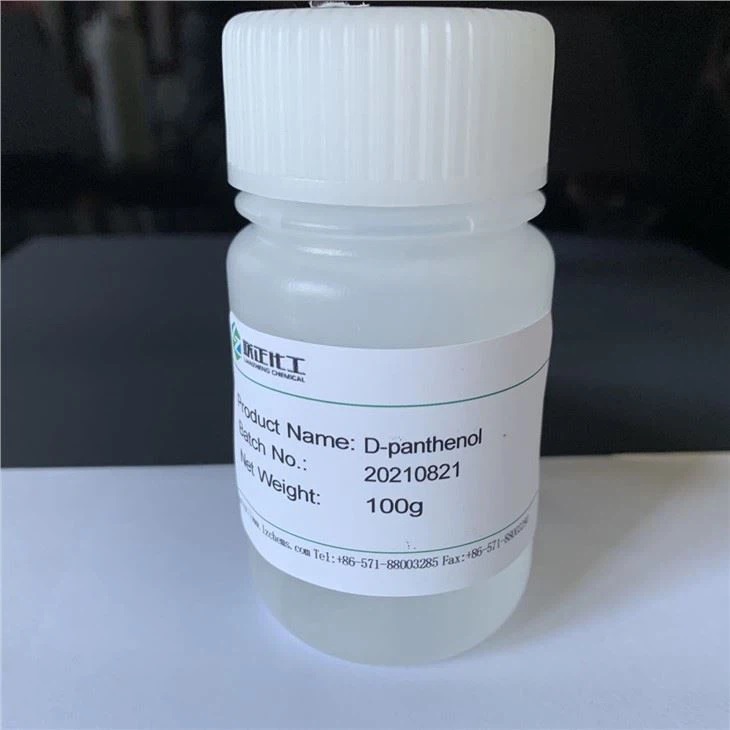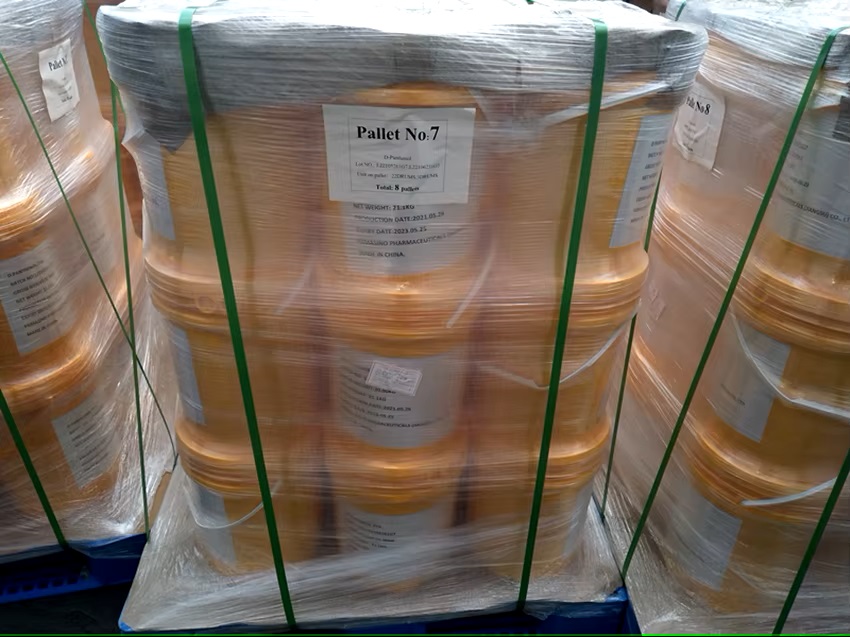Construction, Mining, Metal
Do you have questions?
We unleash your business potential by maximize the business innovation.
Send EmailPanthenol, dl-panthenol, 16485-10-2 ,Dexpanthenol, 81-13-0, lopan, Cozyme, Motilyn, Panyonyl, Bepantol, Intrapan, Pantenyl, Bepanthen, Panthoderm, Bepanthene, pantothenol
dl-panthenol
CAS: 16485-10-2
Molecular Formula: C9H19NO4
Names and Identifiers
| Name | dl-panthenol |
| Synonyms | Panthenol DL-PANTHENOL dl-panthenol D,L-Panthenol dl-pantothenyl alcohol (+-)-pantothenyl alcohol DL-N-PANTOYL-E-PROPANOLAMINE 2,4-dihydroxy-N-(3-hydroxypropyl)-3,3-dimethylbutanamide 4-dihydroxy-n-(3-hydroxypropyl)-3,3-dimethyl-dl-butyramid 4-dihydroxy-n-(3-hydroxypropyl)-3,3-dimethyl-(+-)-butyramid 4-dihydroxy-n-(3-hydroxypropyl)-3,3-dimethyl-(+-)-butanamid DL-2 4-DIHYDROXY-N-(3-HYDROXYPROPYL)-3 3-DIMETHYLBUTYRAMIDE 2,4-dihydroxy-N-(3-hydroxypropyl)-3,3-dimethyl-,(+-)-Butanamide |
| CAS | 16485-10-2 |
| EINECS | 240-540-6 |
| InChI | InChI=1/C9H19NO4/c1-9(2,6-12)7(13)8(14)10-4-3-5-11/h7,11-13H,3-6H2,1-2H3,(H,10,14) |
| InChIKey | SNPLKNRPJHDVJA-UHFFFAOYSA-N |
Physico-chemical Properties
| Molecular Formula | C9H19NO4 |
| Molar Mass | 205.25 |
| Density | 1.166±0.06 g/cm3(Predicted) |
| Melting Point | 66-69 °C (lit.) |
| Boling Point | 118-120 °C(Press: 0.02 Torr) |
| Specific Rotation(α) | 0°(c=5, H2O) |
| Flash Point | 246.3°C |
| Water Solubility | Soluble in water, ethanol, ether, chloroform, and propylene glycol. |
| Solubility | Acetonitrile (Slightly), DMSO (Slightly), Methanol (Slightly) |
| Vapor Presure | 0.004Pa at 25℃ |
| Appearance | White crystal |
| Color | White to Off-White |
| Merck | 14,2947 |
| BRN | 1724945 |
| pKa | 13.03±0.20(Predicted) |
| Storage Condition | Inert atmosphere,Room Temperature |
| Sensitive | Hygroscopic |
| Refractive Index | 1.501 |
| MDL | MFCD00002944 |
| Physical and Chemical Properties | White crystalline hygroscopic powder. Soluble in water, ethanol, methanol and propylene glycol, soluble in chloroform and ether, slightly soluble in glycerol, insoluble in vegetable oil, mineral oil and fat. |
Risk and Safety
| Hazard Symbols | Xn - Harmful |
| Risk Codes | R36/37/38 - Irritating to eyes, respiratory system and skin. R48 - Danger of serious damage to health by prolonged exposure R41 - Risk of serious damage to eyes R37/38 - Irritating to respiratory system and skin. R20/21/22 - Harmful by inhalation, in contact with skin and if swallowed. |
| Safety Description | S26 - In case of contact with eyes, rinse immediately with plenty of water and seek medical advice. S37 - Wear suitable gloves. S45 - In case of accident or if you feel unwell, seek medical advice immediately (show the label whenever possible.) S36/37/39 - Wear suitable protective clothing, gloves and eye/face protection. S22 - Do not breathe dust. |
| WGK Germany | 3 |
| RTECS | ES4316500 |
| FLUKA BRAND F CODES | 3 |
| TSCA | Yes |
| HS Code | 29362400 |
Reference Information
| LogP | -1.02 at 22℃ |
| traits | provitamin B5 is a white crystalline hygroscopic powder. Provitamin B5 can promote the metabolism of human protein, fat and sugar, protect skin and mucous membrane, improve hair color and luster, and prevent the occurrence of diseases. |
| properties | D-panthenol is easily soluble in water, ethanol, methanol and propylene glycol, soluble in chloroform and ether, slightly soluble in glycerin, insoluble in vegetable oil, mineral oil and fat. |
| identification test | is the same as the identification test of "D-panthenol (01011). |
| content analysis | is the same as "D-panthenol (01011). |
| toxicity | GRAS(FDA § 182.5580,2000). |
| use limit | is limited to GMP (FDA 182.5580,2000). |
| use | pharmaceutical intermediates. |
Dexpanthenol
CAS: 81-13-0
Molecular Formula: C9H19NO4
Names and Identifiers
| Name | Dexpanthenol |
| Synonyms | Ilopan Cozyme Motilyn Panyonyl Bepantol Intrapan Pantenyl Bepanthen Panthoderm Bepanthene pantothenol D-Panthenol Alcopan-250 Dexpanthenol (+)-Panthenol pantothenylol pantothenyl alcohol N-pantoyl-3-propanolamine Butanamide, 2,4-dihydroxy-N-(3-hydroxypropyl)-3,3-dimethyl- (R)-2,4-Dihydroxy-N-(3-hydroxypropyl)-3,3-dimethylbutanamide 4-dihydroxy-n-(3-hydroxypropyl)-3,3-dimethyl-d-(+)-butyramid (2S)-2,4-dihydroxy-N-(3-hydroxypropyl)-3,3-dimethylbutanamide (2R)-2,4-dihydroxy-N-(3-hydroxypropyl)-3,3-dimethylbutanamide 4-dihydroxy-n-(3-hydroxypropyl)-3,3-dimethyl-(theta)-butanamid Butanamide, 2,4-dihydroxy-N-(3-hydroxypropyl)-3,3-dimethyl-, (R)- D(+)-ALPHA,GAMMA-DIHYDROXY-N-[3-HYDROXYPROPYL]-BETA,BETA-DIMETHYLBUTYRAMIDE |
| CAS | 81-13-0 |
| EINECS | 201-327-3 |
| InChI | InChI=1/C9H19NO4/c1-9(2,6-12)7(13)8(14)10-4-3-5-11/h7,11-13H,3-6H2,1-2H3,(H,10,14)/t7-/m1/s1 |
| InChIKey | SNPLKNRPJHDVJA-ZETCQYMHSA-N |
Physico-chemical Properties
| Molecular Formula | C9H19NO4 |
| Molar Mass | 205.25 |
| Density | 1.20 g/mL at 20 °C (lit.) |
| Melting Point | 64~69℃ |
| Boling Point | 118-120 °C (2.7 mmHg) |
| Specific Rotation(α) | 30.5 º (c=5, H2O on anh. sub) |
| Flash Point | 118-120°C/0.02m |
| Water Solubility | soluble |
| Solubility | Soluble in water, ethanol, methanol, chloroform, slightly soluble in ether. Insoluble in fat and oil. |
| Vapor Presure | 0Pa at 25℃ |
| Appearance | Yellow-like viscous liquid |
| Color | Clear colorless to slightly yellow |
| Merck | 14,2947 |
| BRN | 1724947 |
| pKa | 13.03±0.20(Predicted) |
| PH | pH (100g/l,25℃) : 8.5~10.5 |
| Storage Condition | 2-8°C |
| Sensitive | Hygroscopic |
| Refractive Index | 1.495-1.502 |
| MDL | MFCD00065006 |
| Physical and Chemical Properties | Density 1.20 boiling point 118-120°C refractive index 1.495-1.502 specific optical rotation 30.5 ° (c = 5, H2O on anh. sub) water soluble |
| Use | Widely used in medicine, food, cosmetics and liquid preparations |
Risk and Safety
| Hazard Symbols | Xn - Harmful |
| Risk Codes | R36/37/38 - Irritating to eyes, respiratory system and skin. R48 - Danger of serious damage to health by prolonged exposure R41 - Risk of serious damage to eyes R37/38 - Irritating to respiratory system and skin. R20/21/22 - Harmful by inhalation, in contact with skin and if swallowed. |
| Safety Description | S23 - Do not breathe vapour. S24/25 - Avoid contact with skin and eyes. S45 - In case of accident or if you feel unwell, seek medical advice immediately (show the label whenever possible.) S36/37/39 - Wear suitable protective clothing, gloves and eye/face protection. S26 - In case of contact with eyes, rinse immediately with plenty of water and seek medical advice. S22 - Do not breathe dust. |
| WGK Germany | 1 |
| RTECS | ES4316000 |
| FLUKA BRAND F CODES | 3-10 |
| TSCA | Yes |
| HS Code | 29241990 |
| Toxicity | LD50 oral in mouse: 15gm/kg |
Introduction
It is more stable in aqueous solution, but prolonged heating causes racemization.
| LogP | -1.06 at 22℃ |
| Introduction | D-panthenol (D-panthenol) is an active compound of D-pantothenic acid and a precursor of coenzyme A, it is an important vitamin drug, which can be converted into pantothenic acid and then synthesized into coenzyme A. It promotes the metabolism of human protein, fat and carbohydrate, protects the mucous membrane and luster of skin surface, and prevents the occurrence of diseases, D-panthenol as a nutritional supplement, widely used in medicine, food, cosmetics industry, specific preparations such as Oral Liquid, eye drops, multi-vitamin injection, shampoo, mousse, skin cream, etc. |
| properties | is a colorless to yellowish transparent viscous liquid that may crystallize during long-term low-temperature storage. There is a slight special odor, easy to absorb moisture. D-panthenol soluble in water, methanol, ethanol, insoluble in ether, chloroform, oil and fat. It is relatively stable in air and light. |
| Application | dexpanthenol (D-panthenol) is an active compound of D-pantothenic acid and a precursor of coenzyme A, it is an important vitamin drug, which can be converted into pantothenic acid and then synthesized into coenzyme A. It promotes the metabolism of human protein, fat and carbohydrate, protects the mucous membrane and luster of skin surface, and prevents the occurrence of diseases, D-panthenol as a nutritional supplement, widely used in medicine, food, cosmetics industry, specific preparations such as Oral Liquid, eye drops, multi-vitamin injection, shampoo, mousse, skin cream, etc. |
| range of use | is widely used in the pharmaceutical, food, and cosmetic industries. In the pharmaceutical industry, as a vitamin B drug, involved in metabolism; In the food industry, used as a nutritional supplement and fortifier, promote the metabolism of human protein, fat, carbohydrate, maintain the skin and mucous membranes, improve hair gloss, improve immunity, prevent the occurrence of diseases; In the cosmetics industry: the role of care on the skin is manifested in the deep penetration of moisturizers, stimulate the growth of epithelial cells, promote wound healing, anti-inflammatory effect; The role of care on the hair is manifested in a lasting moisturizing function, prevent split hair, damage, increase the density of the hair, improve the luster of the hair; the nursing of the nail is manifested by improving the hydration of the nail and imparting flexibility to the nail. |
| identification test | in 1 Ml of 10% sample solution, add sodium hydroxide solution (TS-224)5Ml and copper sulfate solution (TS-78) drops, vigorous shaking. Should present dark blue. 1 ml of 1mol/L hydrochloric acid was added to 1 ml of 1% aqueous sample solution, and the mixture was heated on a steam bath for about 30min. After cooling, 100mg of hydroxylamine hydrochloride was added and mixed well, and 5ml of sodium hydroxide solution (TS-224) was added. After standing for 5min, the pH value was adjusted to 2.5-3.0 with 1mol/L hydrochloric acid, and 1 drop of ferric chloride test solution (TS-101) was added. Should appear reddish purple. |
| content analysis | accurately weigh a sample of about 400mg and place it in a reflux flask with a standard port, add 50.0mL 0.1mol/L perchloric acid in glacial acetic acid solution and reflux for 5H. After cooling, the condenser was covered with a metal foil to prevent water contamination, and the condenser was rinsed with glacial acetic acid. Add 5 drops of crystal violet test solution (TSl74), then use 0.1mol/L potassium hydrogen phthalate glacial acetic acid solution titration to Blue Green end point. At the same time, the blank test was carried out and the necessary correction was made. Perchloric acid is equivalent to 20.53mg of panthenol (C9H1 9NO4) per mL of 0.1mol/L. |
| toxicity | GRAS(FDA,§ 182.5580,2000). |
| Use | for hair care, skin moisturizers, and helps skin wound healing, fight inflammation, It is widely used as pharmaceutical intermediates in medicine, food, cosmetics and liquid preparations . is a precursor of vitamin B5. |
| production method | 1. D-pantolactone and 3-aminopropanol were mixed in methanol and condensed. The reaction was as follows: |

